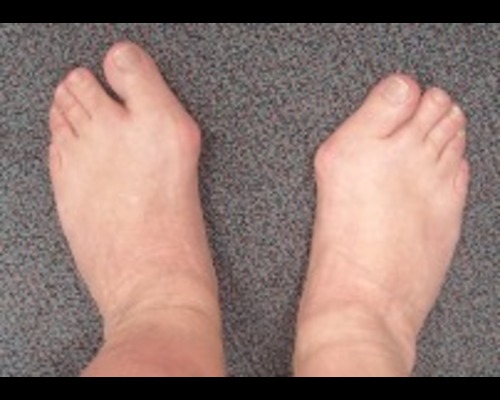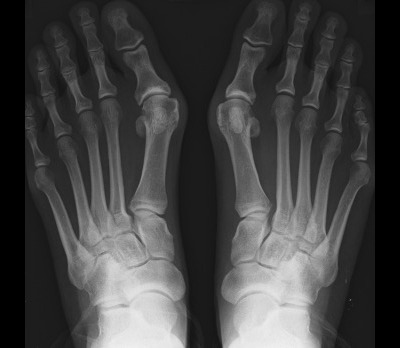Hallux Valgus (Bunions)
Anatomy of the Foot and Hallux Valgus
The big toe, or hallux, plays a crucial role in supporting the body’s weight and aiding in balance during walking and running. In a healthy foot, the big toe points straight ahead. Hallux valgus, commonly known as a bunion, occurs when the big toe begins to angle outward toward the smaller toes, creating a visible bump on the inside of the foot at the base of the toe. This deformity can lead to discomfort, pain, and further complications in the foot.
What is Hallux Valgus (Bunions)?
Hallux valgus is one of the most common foot deformities, particularly in societies where shoes are worn regularly. The exact cause of hallux valgus is not fully understood, but it is believed to result from an imbalance in the ligaments and muscles around the big toe, with contributing genetic factors. Although it is often linked to footwear, such as narrow or high-heeled shoes, this is not considered the sole cause of the condition.
It is important to note that hallux valgus is not a form of arthritis, although some individuals with the condition may also develop arthritis in the affected joint.


What Happens in Hallux Valgus?
In hallux valgus, the first metatarsal bone begins to shift outward while the big toe angles inward toward the smaller toes. This creates the characteristic bump on the inside of the foot, which can become painful over time due to friction with footwear. As the deformity progresses, the altered alignment of the big toe can cause additional strain on the other toes, leading to secondary issues such as hammertoes, corns, calluses, and overlapping toes.
Patients with hallux valgus may notice a large bump on the side of the foot, discomfort when wearing shoes, and pain in the forefoot due to the inefficient function of the big toe. However, the severity of the deformity does not always correlate with the level of pain—some individuals with significant deformities may experience little discomfort, while others with smaller deformities may have more severe symptoms.
Symptoms of Hallux Valgus
- A visible bump on the inside of the foot at the base of the big toe.
- Pain and tenderness over the bunion, especially when wearing shoes.
- Swelling and redness around the joint.
- Difficulty finding comfortable footwear.
- Pain in the forefoot due to overload on the other metatarsals.
- Progressive deformity of the lesser toes (e.g., hammertoes).
How is Hallux Valgus Diagnosed?
Diagnosis of hallux valgus is typically made through a physical examination and the patient’s medical history. The key components of the diagnostic process include:
Physical Examination: The physician will evaluate the foot for the presence of the bunion and any related deformities in the lesser toes.
Imaging: X-rays may be used to assess the severity of the deformity, evaluate the alignment of the bones, and rule out associated conditions like arthritis.
How is Hallux Valgus Treated?
Treatment for hallux valgus depends on the severity of the deformity and the level of discomfort experienced by the patient. Conservative treatments aim to relieve symptoms and slow the progression of the deformity, while surgical options are considered when non-surgical measures fail to provide adequate relief.
Non-Surgical Treatment
- Footwear Modifications: Wearing shoes with a wide toe box and soft uppers can help accommodate the bunion and reduce pressure on the affected area.
- Pressure Relieving Pads: Pads placed over the bunion can reduce friction and protect the skin from irritation.
- Toe Taping or Splinting: Taping the big toe into a more natural alignment can provide temporary relief in mild cases.
- Callus Shaving: Regular removal of calluses can help reduce pain and discomfort in the forefoot.
- Orthotic Devices: Custom orthotics may be prescribed to improve foot mechanics and alleviate stress on the bunion.
While these non-surgical treatments can help manage symptoms, they do not correct the underlying deformity.
Surgical Treatment
Surgery is considered when hallux valgus causes significant pain and impairs daily activities. The goal of surgery is to realign the bones of the foot, reduce the size of the bump, and restore normal function to the big toe.
There are several surgical techniques used to correct hallux valgus, including:
- Minimally Invasive Surgery (MIS): A less invasive option that involves smaller incisions and typically allows for faster recovery.
- Conventional Open Osteotomies: Procedures such as the Scarf and Akin osteotomies involve cutting and realigning the bones of the big toe to correct the deformity.
- Great Toe Fusion: In severe cases, fusion of the big toe joint may be required to provide long-term stability and pain relief.
In many cases, additional procedures to correct secondary deformities, such as hammertoes, may be performed at the same time.
Post-Surgical Care
Following surgery, patients are typically required to stay off the foot for 7 to 10 days. Rehabilitation involves gradual weight-bearing and wearing protective footwear or an ankle brace for 4 to 6 weeks. Full recovery may take several months, with physical therapy recommended to restore range of motion and strength.
Prevention of Hallux Valgus
Preventing hallux valgus involves wearing properly fitted shoes that allow ample room for the toes, avoiding high heels and shoes with a narrow toe box. Maintaining foot flexibility and strength through regular exercises can also help reduce the risk of developing deformities.
Summary
Hallux valgus, or bunions, is a common foot deformity that can cause significant discomfort and lead to secondary issues such as hammertoes and calluses. While non-surgical treatments such as footwear modifications and padding can alleviate symptoms, surgical correction is often required for more severe deformities. With proper diagnosis and treatment, most individuals can achieve relief from pain and restore the function of the big toe.

